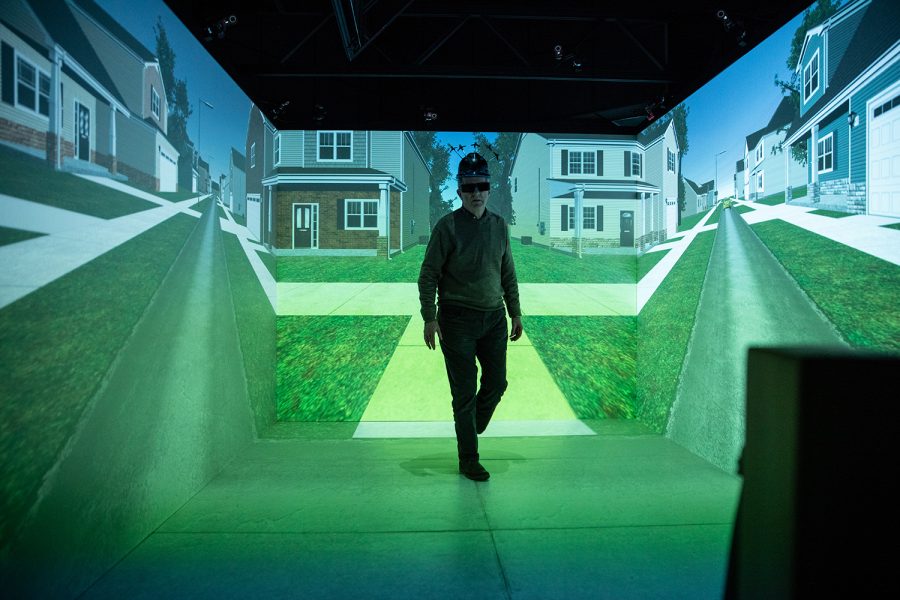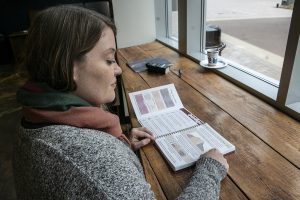Advanced virtual-reality tech helps UI scientists study pedestrian behavior
State-of-the-art technologies at the Hank Lab combine psychology and computer science to study pedestrian behavior.
Hank Lab Co-Director Joe Kearney walks through one of the virtual reality environments wearing a headset with sensors attached at Hank Virtual Laboratory on October 24, 2019. The lab conducts research on pedestrian behavior, and has collaborated with companies such as Toyota.
October 27, 2019
Virtual-reality goggles, real-life simulations, and a cave-like environment are just a few of the many resources the University of Iowa Hank Virtual Environments Lab provides to researchers who combine psychology with computer science to study pedestrian behavior.
The Hank Virtual Environments Lab created immersive, high-tech environments to test a variety of pedestrian behaviors — including children’s behavioral development and bicycling simulations that use college students and community members as part of the studies.
“There are a limited number of pedestrian simulators in the world, and none that are as advanced as ours that I’m aware of,” said Elizabeth O’Neal, a postdoctoral research fellow at the Hank Virtual Environments Lab.
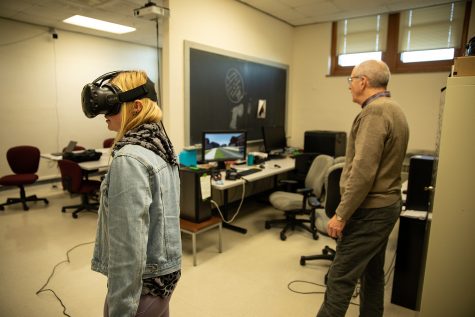
Lab Manager Jessica Flathau wears a headset used to mimic a create a virtual environment while Hank Lab Co-Director Joe Kearney watches on a monitor at Hank Virtual Laboratory on October 24, 2019. The lab conducts research on pedestrian behavior, and has collaborated with companies such as Toyota.
O’Neal added that the lab offered a perfect match for the type of research she wanted to pursue.
“Their virtual environment was ideal for what I’m interested in, which was studying parent-child conversations about safety and how we might be able to develop interventions to improve those conversations,” O’Neal said.
RELATED: UI researchers to demonstrate virtual-reality headsets to Congress
One of the lab’s pedestrian virtual environments surrounds participants with screens on both sides — one straight ahead and one on the floor — that contributes to the immersive experience that O’Neal and other researchers need for testing.
“Our cave-like virtual environments allow you to be fully immersed,” O’Neal said. “They allow you to see your body as you cross, which may be important for how you time movement.”
Joseph Kearney, a computer-science professor in the lab, said dramatic advancements in the last decade for several technologies have allowed the field to reach its current state.
“One [advancement] is graphics cards, driven in large part by gaming. One is displays, particularly the cell phone-like displays, particularly driven by the commodity market in cell phones,” Kearney said. “Another is tracking systems because in order to do all of this you need to know where the person is. The other is the software to build these systems.”
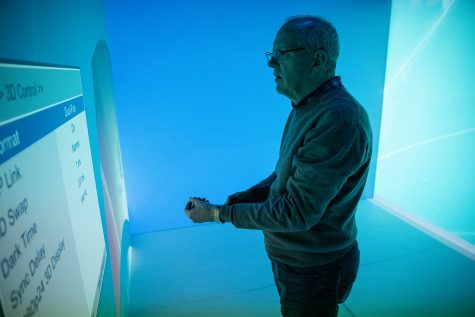
Hank Lab Co-Director Joe Kearney adjusts the settings of a projector in one of the virtual environments at Hank Virtual Laboratory on October 24, 2019. The lab conducts research on pedestrian behavior, and has collaborated with companies such as Toyota.
Kearney said while the programs used to be created from scratch in the labs, the necessary programs are now available to the public for free.
Lab coordinator Jessica Flathau said the interdisciplinary nature of the lab’s research is critical to its success.
“The computer science helps us develop all our experiments, and with psychology we can really make sure these experiments are not just demonstrations, [so] we can see produced results out of them,” Flathau said.
Flathau said the lab’s work focuses a lot on the behavioral development of children’s risk-taking behavior, and it incorporates college students’ results as comparisons which helps elementary-psychology students accrue research credits.
O’Neal said part of the lab’s research has been pinpointing developmental trajectories in a child’s cognition of the risks in street crossing.
“What we found is that kids don’t look like adults in how they select gaps for crossing and time their movements until they’re 14,” O’Neal said.
RELATED: Virtual reality aids Alzheimer’s research
Although this does not mean that children younger than 14 can never cross the street safely, O’Neal said it means that younger children can pick the same safe moments to cross between cars as adults but don’t time their movements as well.
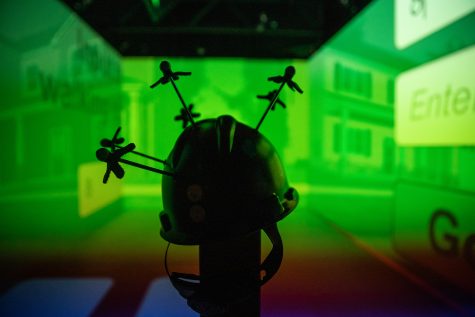
A helmet attached with sensors sits on a post at Hank Virtual Laboratory on October 24, 2019. The lab conducts research on pedestrian behavior, and has collaborated with companies such as Toyota.
O’Neal said researchers consider the approaching car that presents the danger to crossing as the “tail car.”
“[Children] have less time to spare between themselves and the tail car that is approaching,” O’Neal said.
O’Neal believes that the lab’s findings will provide a valuable intervention to foster communication between parents and children in hopes of improving children’s development of anticipatory abilities as pedestrians.
“We always have [students] leave the lab going, ‘That was awesome! It was so much better than staring at a computer screen and pushing buttons all day,’ ” O’Neal said.



